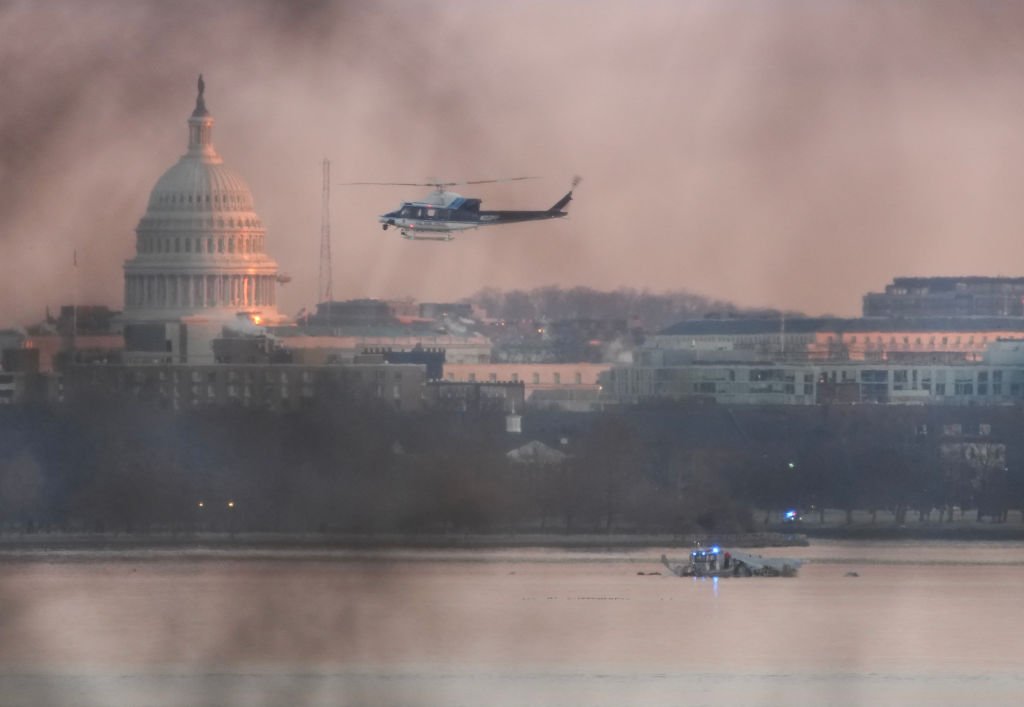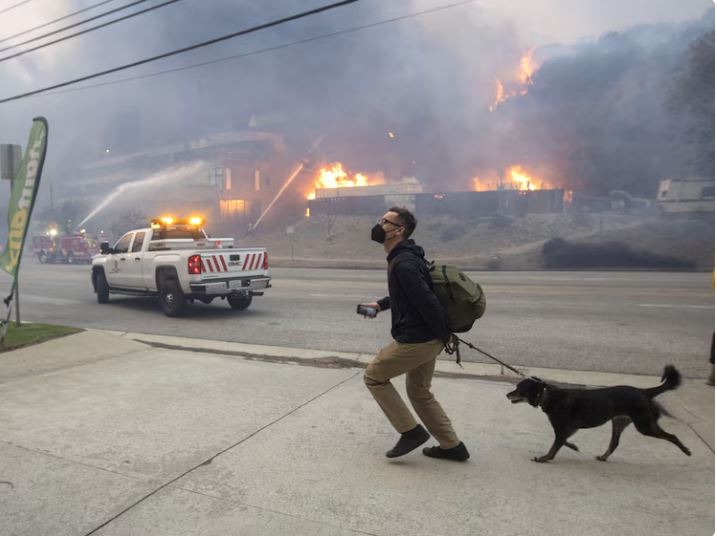Expert explains what may have caused military helicopter to crash into American Airlines jet, killing 67
An expert has weighed in on what could have caused the military helicopter to come into the path of the American Airlines flight.
The tragic incident unfolded on January 29 after American Airlines flight 5342 collided with a Black Hawk helicopter while coming in to land at Ronald Reagan Washington National Airport.

The plane reportedly split in two and plunged into the Potomac River. Authorities have revealed that out of the 64 people aboard the plane and three on the helicopter, there are believed to be no survivors.
An investigation is ongoing into the incident, as authorities attempt to piece together how this devastating incident occurred.
Investigators believe a series of miscommunications in one of the nation’s most congested airspaces may have played a critical role in the crash, per the New York Post.
Less than 20 seconds before the collision, an air traffic controller cautioned the Black Hawk pilot that the helicopter was too close to the incoming CRJ-700 passenger plane.
The pilot acknowledged the warning, but aviation experts suggest he may have mistaken a different jet – another CRJ-700 taking off farther away – for the one on approach and maneuvered accordingly.

The Black Hawk was reportedly flying at around 400 feet – well above its designated altitude – when it struck the descending American Airlines jet, which had been cleared for landing.
Given the restricted airspace around Reagan National, where the altitude separation between helicopters and landing aircraft is just 50 feet, even minor errors can have disastrous consequences.
While officials have yet to determine an official cause of the crash, Transportation Secretary Sean Duffy stated Thursday that the tragedy was “absolutely” preventable.
Former American Airlines pilot John Wright highlighted the difficulties of navigating the airport’s relatively short 7,000-foot runway compared to the 13,000-foot runways at other major airports.
“When it was originally built [in 1941,] there weren’t jet airplanes, which need to take a lot more space than propeller-driven airplanes,” Wright explained to the New York Post.
He noted that pilots must be highly focused when landing at Reagan National. “The first few times you fly there, you usually are with [a fellow pilot] who’s really experienced. He’s kind of talking through it, too,” he said.
.jpg_Yi9Mrv?tr=w-1024,cr-0.0.1024.686&config=JTdCJTIyYWx0ZXJuYXRpdmVfdGV4dCUyMiUzQSUyMkdldHR5SW1hZ2VzLTIxOTY3NTQ1NTglMjAoMSkuanBnJTIyJTJDJTIyY2FwdGlvbiUyMiUzQSUyMlJlY292ZXJ5JTIwdGVhbXMlMjBwdWxsaW5nJTIwdGhlJTIwd3JlY2thZ2UlMjBmcm9tJTIwdGhlJTIwcml2ZXIuJTIwQ3JlZGl0JTNBJTIwV2luJTIwTWNOYW1lZSUyMCUyRiUyMEdldHR5JTIyJTJDJTIyY29vcmRpbmF0ZXMlMjIlM0ElN0IlMjJkZXNrdG9wJTIyJTNBJTdCJTIybGVmdCUyMiUzQTAlMkMlMjJ0b3AlMjIlM0EwJTJDJTIycmlnaHQlMjIlM0ExJTJDJTIyYm90dG9tJTIyJTNBMC42NyU3RCUyQyUyMnRhYmxldCUyMiUzQSU3QiUyMmxlZnQlMjIlM0FudWxsJTJDJTIydG9wJTIyJTNBbnVsbCUyQyUyMnJpZ2h0JTIyJTNBbnVsbCUyQyUyMmJvdHRvbSUyMiUzQW51bGwlN0QlMkMlMjJtb2JpbGUlMjIlM0ElN0IlMjJsZWZ0JTIyJTNBbnVsbCUyQyUyMnRvcCUyMiUzQW51bGwlMkMlMjJyaWdodCUyMiUzQW51bGwlMkMlMjJib3R0b20lMjIlM0FudWxsJTdEJTdEJTJDJTIyd2lkdGglMjIlM0ExMDI0JTJDJTIyaGVpZ2h0JTIyJTNBNjgzJTJDJTIydXVpZCUyMiUzQSUyMmZjODk0NzAyLWNiYjMtNDRlNy1hZDlhLThmMDZlOGNmMzQxMl9fd3AtY29udGVudCUyRnVwbG9hZHMlMkZHZXR0eUltYWdlcy0yMTk2NzU0NTU4KDEpLmpwZ19ZaTlNcnYlMjIlN0Q=)
Adding to the complexity, two flight paths – one for helicopters and another for airplanes – converge near the airport, increasing the likelihood of near misses if procedures aren’t followed precisely.
Some experts believe the air traffic controller’s warning to the Black Hawk pilot may have been too general.
Retired Black Hawk pilot Lt. Col. Darin Gaub pointed to air traffic communication protocols that typically include precise directional cues, such as: “Black Hawk, do you see the aircraft at your 11 o’clock, five miles out, moving north?”
Instead, the controller simply referred to the aircraft type – “CRJ” – without specifying its exact location. Gaub suggested this could have contributed to the pilot’s possible misidentification of the approaching jet.
However, former Air Force pilot and Rep. Adam Kinzinger (R-Calif.) defended the air traffic controllers, saying in a video posted to X that they “did their job” by alerting the helicopter of the jet’s approach.
“If you listen to the audio, the [commercial jet] was coming in on approach [when air traffic control] called out to [the army helicopter], ‘Look for the [jet] on approach’ – that’s air traffic control’s job,” Kinzinger said. “[The helicopter] evidently saw the wrong target – this is the theory – and said, ‘I see the [airplane].’”
Although the crash occurred on a clear night, visibility may have been affected by the helicopter crew’s use of night-vision goggles.
Gaub noted that these goggles reduce a pilot’s field of vision to about 40 degrees, making it more difficult to spot other aircraft.
He also explained that city lights could blend with an aircraft’s navigation lights, making it challenging to identify another plane in a busy airspace.
“I’ve had it happen to me before,” he said. “I know exactly how it looks, and you can lose an entire 747 in the lights of a big city.”
The helicopter’s altitude at the time of the collision is another focal point of the investigation. Regulations limit helicopters to a maximum altitude of 200 feet in the area, but the crash occurred at roughly 300 feet.
“If the helicopter was flying at an altitude that was higher than what is prescribed and dictated by procedure through that airspace corridor… they could have been looking at an aircraft that was… potentially even below their own altitude,” Gaub said, per FOX News.

Even if the helicopter had been flying at its correct altitude, aviation attorney and former pilot Jim Brauchle noted that the airspace design leaves little room for error.
“You’ve got intersecting routes that are apparently de-conflicted by, you know, only several hundred feet – which is not a lot of room for a margin of error,” Brauchle said.
Adding to the risk, FAA regulations allow for a standard 75-foot deviation from assigned altitudes, which could have further reduced the separation between aircraft.
Wright argued that the helicopter should not have been in the flight path at all.
“Somehow something broke down between the helicopter’s clearance to be there and the air traffic control tower,” he said.
“It kind of seems like a very preventable accident that shouldn’t have happened if normal procedures were followed.”





